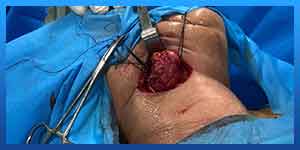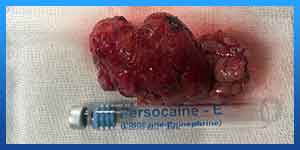Author : Dr Maryam Mosleh
What is the submandibular gland?
The submandibular glands are a pair of salivary glands under the jaw bone. Each gland produces saliva which goes through a long duct to its opening under the tongue at the front of the mouth. The production of saliva increases when we eat. The saliva secreted by the submandibular gland is a bit thicker than that produced by other salivary glands.
Because of its thickness this saliva can sometimes form little stones.

Before Submandibular Gland Surgery
What problems can you have with the submandibular gland?
The commonest problem is blockage of the salivary duct. This can be caused by the presence of stones or simply a narrowing of the salivary duct. Blockage of the salivary duct can cause a painful swelling of the gland when you eat. Sometimes the swelling may settle on its own. When the blockage is severe, it can lead to persistent inflammation of the gland.
Occasionally, a painless lump may develop within the submandibular gland. Those lumps are often benign but need thorough checking, as up to half of them may be or become cancerous. Even benign lumps can get gradually bigger.
Symptoms
Sometimes lumps or stones cause a blockage in the drainage tubes. Symptoms of problems with your submandibular glands may include:
. Swelling
. Discomfort when opening your mouth
. Dry mouth
. Face or mouth pain
. Bad taste in your mouth
If conservative treatment of your submandibular glands is not successful your consultant may recommend removal.

Diagnosis
What investigation are you likely to have?
. An X-ray or CT scan of the submandibular gland:
This is to see if there are stones inside the gland or the duct.
. Sialogram:
The doctor fills the duct at the front of the mouth with some contrast liquid and then takes x-rays. This will show up stones or narrowing inside the duct.
. Ultrasound:
This test uses sound waves to detect any lumps inside the gland.
. Fine needle aspiration:
This can help to find out the nature of the lump. The doctor uses a fine needle to draw some cells out from the lump. The cells are sent to the laboratory for analysis.

Read more about : What is Thyroidectomy?
Possible Complications
. Scarring
. Blood clot
A blood clot can collect beneath the skin (this is called a haematoma). This occurs in up to 5% of patients and it is sometimes necessary to return to the operating theatre and remove the clot and replace the drain.
. Wound infection
This is uncommon in the neck but can happen if the submandibular gland was badly infected. Wound infection will require antibiotic treatment. Pus collected under the skin may need to be drained.
. Facial weakness
There is an important nerve that passes under the chin close to the submandibular gland. It makes the lower lip move. If it is damaged during the surgery it can lead to a weakness of the lower lip. In most cases this nerve works normally after the surgery, however in some cases weakness of the lower lip can occur, particularly when the gland is badly inflamed or if the nerve is stuck to a lump. This weakness is usually temporary and can last for 6-12 weeks. Occasionally there is a permanent weakness of the lower lip following this surgery.
. Numbness of the face and ear
The skin around the wound may be numb after the operation. If that happens the numbness will usually improve over the next three months.
. Numbness of tongue
The nerve which gives sensation and taste to one half of the tongue runs close to the duct of the gland. It very rarely gets injured. However, if this nerve is damaged your tongue may feel numb immediately after the operation. This will usually go, and permanent numbness of the tongue is rare.
. Injury to the nerve that ‘moves’ the tongue
Another nerve runs close to the submandibular gland that supplies the muscles of the tongue on that side (and hence helps with movement of the tongue). It would be very unusual for this nerve to be damaged in this surgery. If it were to occur, it is unlikely to produce any noticeable disability.
Read more about : What is Chemotherapy?
Why it's done
. If stones inside the duct do not come out, the gland may swell up when you eat. These stones can be removed. This procedure is done through the mouth either under a local or general anaesthetic. Your consultant will discuss the options with you.
. If stones are stuck inside the submandibular gland, the gland can become permanently inflamed and swollen. If it gives you undue discomfort over a longer time, your specialist may advise to have the gland removed.
. If a lump has developed in the submandibular gland, your surgeon may recommend removing the gland. As a fairly high number of submandibular lumps can be cancerous the whole gland should be removed. By removing the gland we can find out whether it is benign or cancerous.
You may change your mind about the operation at any time, and signing a consent form does not mean that you have to have the operation.
If you would like to have a second opinion about the treatment, you can ask your specialist. He or she will not mind arranging this for you. You may wish to ask your own GP to arrange a second opinion with another specialist.
Read more about : What is a deviated septum?
Preparing for surgery
Prepare for the surgery as you have been instructed. Be sure to tell your healthcare provider about all medicines you take. This includes over-the-counter medicines. It also includes herbs and other supplements. You may need to stop taking certain ones before surgery as directed by your healthcare provider. Also, follow any directions you’re given for not eating or drinking before surgery.
During Submandibular Gland Surgery
During procedure
Submandibular gland removal is usually done under general anaesthetic and takes about one hour. Your surgeon will make an incision (cut) in your neck just below your jaw bone. They will access and remove all or part of your submandibular gland. A tiny drain will be placed in the incision to allow excess fluid or blood to drain away. Your wound will be closed with stitches.
Immediately after your operation you will be taken to a recovery area where we will monitor you until you have recovered from the anaesthetic. If you are in any pain we will give you pain relief medication.
You will need to stay in hospital until your drain can be removed. This usually requires an overnight stay.
After Submandibular Gland Surgery
Recovery
Submandibular gland removal is surgery to take out a saliva gland below the lower jaw. The gland may have been removed because of infection, a tumour, or a blocked saliva duct. A saliva duct is a tube that carries saliva from the gland into the mouth.
The area below your jaw may be sore for several days after your surgery. The area also may be slightly swollen or bruised. It will probably take 1 to 2 weeks for the cut (incision) the doctor made to heal.
If you have stitches in your incision, your doctor may need to remove them, or they may dissolve on their own. Ask your doctor about this. If your incision was closed with glue, the glue will peel off on its own in the weeks after your surgery.
This care sheet gives you a general idea about how long it will take for you to recover. But each person recovers at a different pace. Follow the steps below to get better as quickly as possible.
Read more about : Jaw surgery
How can you care for yourself at home?
. Activity
. Rest when you feel tired. Getting enough sleep will help you recover. For 4 or 5 days after surgery, sleep with your head up by using two or three pillows. You can also try to sleep with your head up in a reclining chair.
. Try to walk each day. Start by walking a little more than you did the day before. Bit by bit, increase the amount you walk. Walking boosts blood flow and helps prevent pneumonia and constipation.
. Avoid strenuous activities, such as bicycle riding, jogging, weight lifting, or aerobic exercise, for 1 week or until your doctor says it is okay.
. For 1 week, avoid lifting anything that would make you strain. This may include a child, heavy grocery bags and milk containers, a heavy briefcase or backpack, cat litter or dog food bags, or a vacuum cleaner.
. Ask your doctor when you can drive again.
. You will probably need to take 1 week off from work. It depends on the type of work you do and how you feel.
. Do not shave the incision for the first 2 weeks or until your doctor says it is okay. It is okay to shave the rest of your neck and face.
. Diet
. You can eat your normal diet. If your stomach is upset, try bland, low-fat foods like plain rice, broiled chicken, toast, and yogurt.
. Drink plenty of fluids to avoid becoming dehydrated.
. You may notice that your bowel movements are not regular right after your surgery. This is common. Try to avoid constipation and straining with bowel movements. You may want to take a fibre supplement every day. If you have not had a bowel movement after a couple of days, ask your doctor about taking a mild laxative.
Read more about : Oral and Maxillofacial Surgery
. Medicines
. Your doctor will tell you if and when you can restart your medicines. He or she will also give you instructions about taking any new medicines.
. If you take aspirin or some other blood thinner, ask your doctor if and when to start taking it again. Make sure that you understand exactly what your doctor wants you to do.
. Be safe with medicines. Take pain medicines exactly as directed.
. If the doctor gave you a prescription medicine for pain, take it as prescribed.
. If you are not taking a prescription pain medicine, ask your doctor if you can take an over-the-counter medicine.
. If you think your pain medicine is making you sick to your stomach:
. Take your medicine after meals (unless your doctor has told you not to).
. Ask your doctor for a different pain medicine.
. If your doctor prescribed antibiotics, take them as directed. Do not stop taking them just because you feel better. You need to take the full course of antibiotics.
. Incision care
. You may have a bandage over the incision. Follow your doctor's instructions about how to take care of this bandage and when to take it off.
. If you have strips of tape on the incision, leave the tape on for a week or until it falls off.
. After your doctor says it is okay to get the incision wet, wash the area daily with warm, soapy water, and pat it dry. You may cover the area with a gauze bandage if it weeps or rubs against clothing. Change the bandage every day.
. Your doctor may give you other instructions about how to care for your incision. Follow your doctor's instructions exactly.
. Keep the area clean and dry.
. Ice
. Put ice or a cold pack on the surgery site for 10 to 20 minutes at a time. Try to do this every 1 to 2 hours for the next 3 days (when you are awake) or until the swelling goes down. Put a thin cloth between the ice and your skin.



